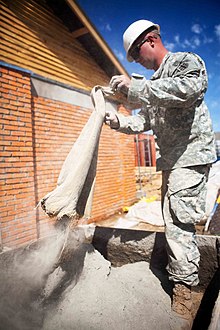What does hydraulic cement mean?
Definitions for hydraulic cement
hy·draulic ce·ment
This dictionary definitions page includes all the possible meanings, example usage and translations of the word hydraulic cement.
Princeton's WordNet
hydraulic cement, Portland cementnoun
a cement that hardens under water; made by heating limestone and clay in a kiln and pulverizing the result
Wikipedia
hydraulic cement
A cement is a binder, a chemical substance used for construction that sets, hardens, and adheres to other materials to bind them together. Cement is seldom used on its own, but rather to bind sand and gravel (aggregate) together. Cement mixed with fine aggregate produces mortar for masonry, or with sand and gravel, produces concrete. Concrete is the most widely used material in existence and is behind only water as the planet's most-consumed resource.Cements used in construction are usually inorganic, often lime or calcium silicate based, which can be characterized as hydraulic or the less common non-hydraulic, depending on the ability of the cement to set in the presence of water (see hydraulic and non-hydraulic lime plaster). Hydraulic cements (e.g., Portland cement) set and become adhesive through a chemical reaction between the dry ingredients and water. The chemical reaction results in mineral hydrates that are not very water-soluble and so are quite durable in water and safe from chemical attack. This allows setting in wet conditions or under water and further protects the hardened material from chemical attack. The chemical process for hydraulic cement was found by ancient Romans who used volcanic ash (pozzolana) with added lime (calcium oxide). Non-hydraulic cement (less common) does not set in wet conditions or under water. Rather, it sets as it dries and reacts with carbon dioxide in the air. It is resistant to attack by chemicals after setting. The word "cement" can be traced back to the Ancient Roman term opus caementicium, used to describe masonry resembling modern concrete that was made from crushed rock with burnt lime as binder. The volcanic ash and pulverized brick supplements that were added to the burnt lime, to obtain a hydraulic binder, were later referred to as cementum, cimentum, cäment, and cement. In modern times, organic polymers are sometimes used as cements in concrete. World production is about four billion tonnes per year, of which about half is made in China. If the cement industry were a country, it would be the third largest carbon dioxide emitter in the world with up to 2.8 billion tonnes, surpassed only by China and the United States. The initial calcination reaction in the production of cement is responsible for about 4% of global CO2 emissions. The overall process is responsible for about 8% of global CO2 emissions, as the cement kiln in which the reaction occurs is typically fired by coal or petroleum coke because a luminous flame is required to heat the kiln by radiant heat transfer. As a result, the production of cement is a major contributor to climate change.
ChatGPT
hydraulic cement
Hydraulic cement is a type of binding material that hardens or sets as a result of a chemical reaction with water, known as hydration. This property allows it to set and become adhesive even under water or when constantly exposed to wet conditions. Hydraulic cement is commonly used in construction projects for its ability to set quickly and provide strong, durable structures. Examples include Portland cement, blast furnace slag cement, and pozzolanic cement.
Matched Categories
Numerology
Chaldean Numerology
The numerical value of hydraulic cement in Chaldean Numerology is: 7
Pythagorean Numerology
The numerical value of hydraulic cement in Pythagorean Numerology is: 8
Translation
Find a translation for the hydraulic cement definition in other languages:
Select another language:
- - Select -
- 简体中文 (Chinese - Simplified)
- 繁體中文 (Chinese - Traditional)
- Español (Spanish)
- Esperanto (Esperanto)
- 日本語 (Japanese)
- Português (Portuguese)
- Deutsch (German)
- العربية (Arabic)
- Français (French)
- Русский (Russian)
- ಕನ್ನಡ (Kannada)
- 한국어 (Korean)
- עברית (Hebrew)
- Gaeilge (Irish)
- Українська (Ukrainian)
- اردو (Urdu)
- Magyar (Hungarian)
- मानक हिन्दी (Hindi)
- Indonesia (Indonesian)
- Italiano (Italian)
- தமிழ் (Tamil)
- Türkçe (Turkish)
- తెలుగు (Telugu)
- ภาษาไทย (Thai)
- Tiếng Việt (Vietnamese)
- Čeština (Czech)
- Polski (Polish)
- Bahasa Indonesia (Indonesian)
- Românește (Romanian)
- Nederlands (Dutch)
- Ελληνικά (Greek)
- Latinum (Latin)
- Svenska (Swedish)
- Dansk (Danish)
- Suomi (Finnish)
- فارسی (Persian)
- ייִדיש (Yiddish)
- հայերեն (Armenian)
- Norsk (Norwegian)
- English (English)
Word of the Day
Would you like us to send you a FREE new word definition delivered to your inbox daily?
Citation
Use the citation below to add this definition to your bibliography:
Style:MLAChicagoAPA
"hydraulic cement." Definitions.net. STANDS4 LLC, 2024. Web. 30 Apr. 2024. <https://www.definitions.net/definition/hydraulic+cement>.



Discuss these hydraulic cement definitions with the community:
Report Comment
We're doing our best to make sure our content is useful, accurate and safe.
If by any chance you spot an inappropriate comment while navigating through our website please use this form to let us know, and we'll take care of it shortly.
Attachment
You need to be logged in to favorite.
Log In